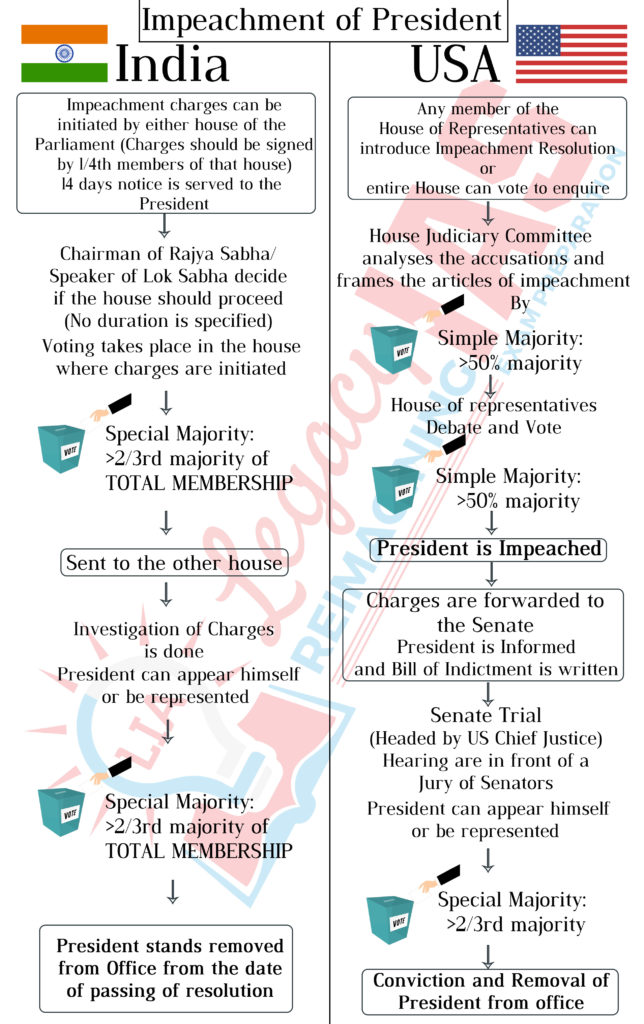While American Constitution is the shortest (of any major government in the world) and the first written constitution, India’s Constitution is the lengthiest written constitution in the World.
| FEATURE | INDIA | USA |
| Adopted | 26th November 1949 | 17th July 1787 |
| Nature | Quasi – federal and works on cooperative federalism | Truly federal – the Centre and state are completely independent |
| Nature of Law making | States are important at the executive level and this is called Executive federation. Seventh Schedule of the Indian Constitution distributes the legislative power between the Central and State governments Residuary powers rest with parliament | States have dominance in law making Legislative federation. No elaborative mechanism is provided |
| Union and states | India is an indestructible union of destructible states | USA is an indestructible union of indestructible state |
| Form of Government | Parliamentary form of government. | Presidential form of government, |
| Office of president | He is indirectly elected Indian President holds the office for five years. President of India is the executive head of the Indian government. President runs the government with the aid and advice of the Council of minister | The people directly elect the executive President. The term of the American President is 4 years The President can appoint his own staff President is independent in the administration of the government and rather directly responsible to the people of USA. |
| Powers of President | President do not enjoy Qualified veto | President enjoys Qualified veto. |
| Legislature | Consist of Lok sabha and Rajya sabha | Has 2 houses. House of representatives and Senate |
| House of representatives vs Lok sabha | Parliament has authority to make any law without the violation of basic structure of constitution. | One of the weakest lower house in the world |
| Senate vs Rajya Sabha | Rajya sabha Not as strong as Senate | Strongest upper house in the world It has equal powers in ordinary bills, amendment bills and money bills. |
| Separation of powers | Doctrine of Separation of Power is adopted in our Constitution, but it is only between the Executive and Judiciary. Term of Legislatures and executives depend on each other, All the members of executive are a part of legislature [except when he/she is not a member for 6 months] The President is a part of the Union Executive and has a role in law making. | US Constitution strictly adheres to the doctrine of Separation of Power The term of Legislature and Executive are fixed and do not depend on each other None of the member of the Legislature can be a member of the Executive The American President has no privilege of law making |
| Fundamental rights | Incorporated in the name of fundamental rights Indian’s have no such right. | In the name of bill of rights. Americans have a right to keep arms and guns for the protection of their life and property |
| Criminal trials | adjudicated by the Judges only. | Criminal offence is adjudicated by a system of “Grand Jury”. Grand Jury means that common people are selected by the government randomly, representing the community. |
| Emergency | Emergency can be declared on the ground of War and Armed Rebellion | Does not use the phrase of emergency but says that in case of Rebellion and Invasion of Public Safety, the writ of Habeas Corpus can be suspended. |
| Judiciary | President appoints Judges to the Supreme Court based on a process, in which the Chief justice and four senior judges of the SC play a very dominant and decisive role. | There is no qualification mentioned for the appointment of judges of the Supreme Court President Suggests the names of judges to the Senate and on the advice and consent of the Senate, judges are appointed by the President. |
India did not copy the US Constitution; it took what worked for it and no more.
- Every constitution offers a particular set of solutions to a social, economic and cultural context.
- India did not copy the US Constitution; it took what worked for it and no more. Moreover, if constitutions are tools for governance, then they simply must change over time, through trial and error.
- Constitutions should be changed as often as their subjects want to change them, to bring about the results they want for their political community.
- Thomas Jefferson suggested that every generation of Americans should draft its own version to meet the particularities of its time.

Similarities between Indian and US constitution
- Written constitution
- Bill of Rights and Fundamental Rights
- Supremacy of the Federal or Union Government
- Powers of Checks and Balances



